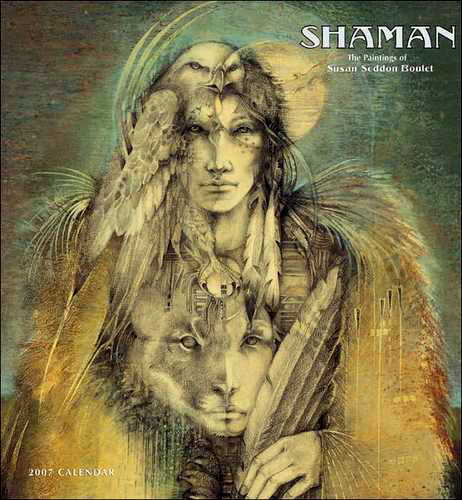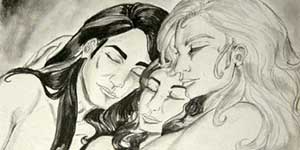The Shifgrethor of Changelings
Sunday, April 27th, 2008“Maybe there are only two sexes: men and mothers.”
Alice Sheldon, writing as James Tiptree Jr. to Joanna Russ

Distracting myself with Google news while laboring over my grant progress reports, I caught sight of a headline exclaiming “Pregnant Man!” Intrigued, I read on, only to become more puzzled. I couldn’t figure out the novelty: the future parent, Thomas Beatie, identifies and is legally classified as male. However, s/he is chromosomally and somatically female, modified by breast surgery and testosterone injections. So Beatie’s fallopian tubes, ovaries and uterus are intact, making this a conventional pregnancy (and not the first of its kind, either).
For me, the real surprise was how reactions split. With few exceptions, women were positive, whether hetero- or homo-sexual. Most men (again, regardless of sexual orientation) were negative, many virulently so, resorting to utterances that could have emanated from fundamentalist tracts. The transgender community was ambivalent — and amazingly there, too, the division was along lines of gender identification. In essence, the men — born or made — were saying: Why would anyone calling himself a man go through this? That’s what women are for! Could this ever happen to me?? Some said this more or less verbatim. Beatie’s pregnancy pushed the buttons of this issue as forcefully as if the coming child had burst, Alien-like, from a male torso.
While I was pondering this, it dawned on me that unconventional biological and social human genders seem to be predominantly the domain of women in speculative fiction, from singletons (Le Guin’s androgynous Gethenians, Constantine’s hermaphroditic Wraeththu, Slonczewski’s parthenogenetic Sharers) to multiples (Scott’s five-gendered post-FTL humans) to bona fide male pregnancy (in Butler’s Bloodchild). Men tend to stick to dyadic genders and traditional family patterns, even when depicting otherwise exotic aliens.
Biologically, the two gametes of terrestrial lifeforms are a result of evolution once it went down the path of sexual reproduction. There is nothing pre-ordained about this outcome, nor does phenotype mirror genotype: many plants and several animals are unisexual or hermaphroditic, while other animals can switch sexes. Too, biomorphic and behavioral outcomes are not invariably binary. Humans are capable of an enormous repertoire of responses, and I cannot think of one that is completely gender-specific. The troubles start with the relative value assigned to the two genders — and to their behavior, conditioned and enforced by edicts throughout the ages that are as arbitrary as they are punitive.
I can understand the worries of the trans community, whose members are trying to gain acceptance as gay people did before them by adopting rigidly orthodox gender roles. Such stereotyped assignations also occurred in cultures that tolerated intersexes: the North American two-spirited, the Indian hijra. However, the men’s objections reminded me of the “eew” reaction of boys to girls, before the hormonal rise (or is it fall?) of puberty overcomes social conditioning. They highlight a profound and visceral male unease over blurred identities or breached boundaries — in bodies, gender roles, power; a wish to make an absolute, immovable distinction between penetrator and penetrated, implanter and implanted.
In most cultures, men are trained to compartmentalize and make a virtue out of this necessity. Additionally, surgery that accentuates sexual dimorphism draws surprisingly little criticism. Beatie’s biggest transgression was becoming a changeling, someone who cannot be easily pigeonholed. Shapeshifters, from Raven to Loki to Star Trek’s Odo, are never trusted even though all mythologies found it necessary to invent them. What set off the fuses was the perception that Beatie is claiming the perks of both genders — if pregnancy can be viewed as such, considering how dangerous it could be (both physically and socially) before the advent of reliable contraception.
In the last few decades, medical advances have made it possible for people to conceive and bear children by assisted reproduction: sperm banks, artificial insemination, in vitro fertilization, surrogate motherhood. Yet all these procedures kept one condition intact: women’s involvement and hence traditional gender roles. Schwarzenegger in Junior notwithstanding, there is no concerted effort to create artificial wombs, which would make childbearing optional for women and possible for men. With the continuing furor over embryonic stem cells, it is unlikely that such an endeavor will be pursued any time soon.
Childbearing and childrearing, even when greatly desired and welcome, take a toll on women individually and collectively, since their investment is much greater. As long as this dichotomy remains, all discussions of true equality (to say nothing of radical social engineering) will remain just vaporous talk. It is possible, of course, that once in vitro pregnancy becomes possible, women will disappear except for a few kept as trophies or specimens — and that humans will designate another group as the perpetual Other. However, I prefer to hope that this will bring true equality, and make everyone able to adopt fluid, flexible identities that, at their best, combine the gentle strength of the Gethenians with the passionate flair of the Wraeththu.
Shifgrethor: to cast a long shadow; prestige, face, place, the pride-relationship, social authority (language of Karhide; Ursula Le Guin, The Left Hand of Darkness).

Credits: Top, Shaman by Susan Seddon Boulet;
Bottom, Tilda Swinton as Gabriel in Constantine.
Note: This post also appeared in George Dvorsky’s Sentient Developments during my guest-blogging stint in May 2009.


 The God Abandons Antony
The God Abandons Antony